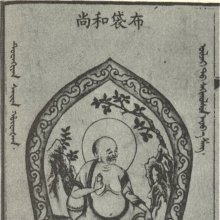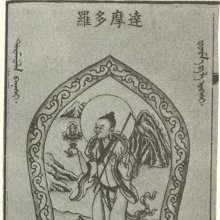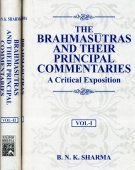Upasaka, Upāsaka, Upashaka: 23 definitions
Introduction:
Upasaka means something in Buddhism, Pali, Hinduism, Sanskrit, the history of ancient India, Marathi, Hindi. If you want to know the exact meaning, history, etymology or English translation of this term then check out the descriptions on this page. Add your comment or reference to a book if you want to contribute to this summary article.
Images (photo gallery)
In Hinduism
Vaishnavism (Vaishava dharma)
Source: Pure Bhakti: Bhagavad-gita (4th edition)Upāsaka (उपासक) refers to “worshipper”. (cf. Glossary page from Śrīmad-Bhagavad-Gītā).
Source: Pure Bhakti: Brhad BhagavatamrtamUpāsaka (उपासक) refers to:—Worshipers or devotees. (cf. Glossary page from Śrī Bṛhad-bhāgavatāmṛta).

Vaishnava (वैष्णव, vaiṣṇava) or vaishnavism (vaiṣṇavism) represents a tradition of Hinduism worshipping Vishnu as the supreme Lord. Similar to the Shaktism and Shaivism traditions, Vaishnavism also developed as an individual movement, famous for its exposition of the dashavatara (‘ten avatars of Vishnu’).
In Buddhism
Theravada (major branch of Buddhism)
Source: Access to Insight: A Glossary of Pali and Buddhist TermsA male/female lay follower of the Buddha. Compare parisa.Source: Dhamma Dana: Pali English GlossaryM Person who supports and respects the "triple gem": Buddha, dhamma and sangha.
Source: Pali Kanon: Manual of Buddhist Terms and Doctrineslit. 'sitting close by', i.e. a 'lay adherent', is any lay follower who is filled with faith and has taken refuge in the Buddha, his doctrine and his community of noble disciples (A.VIII.25).
His virtue is regarded as pure if he observes the 5 Precepts (pañca-sīla; s. sikkhāpada).
He should avoid the following wrong ways of livelihood:
-
trading in arms,
-
trading in living beings,
-
trading in meat,
-
trading in alcohol
-
trading in poison (A.V.177).
See also A.VIII.75.
-- or --
'female adherent'; s. upāsaka.
Theravāda is a major branch of Buddhism having the the Pali canon (tipitaka) as their canonical literature, which includes the vinaya-pitaka (monastic rules), the sutta-pitaka (Buddhist sermons) and the abhidhamma-pitaka (philosophy and psychology).
General definition (in Buddhism)
Source: Wisdom Library: BuddhismUpasaka was a man who has gone to the Three Refuges is called in Pali an upasaka, and a woman an upasika. Being an upasaka or upasika amounts to doing a good deed that will send you to the deva worlds.
India history and geography
Source: Cologne Digital Sanskrit Dictionaries: Indian Epigraphical GlossaryUpāsaka.—(EI 3, 8, 27; CII 3), a Buddhist lay worshipper; a lay follower of the Buddha; cf. Upāsikā. (SII 13), a temple servant. Note: upāsaka is defined in the “Indian epigraphical glossary” as it can be found on ancient inscriptions commonly written in Sanskrit, Prakrit or Dravidian languages.

The history of India traces the identification of countries, villages, towns and other regions of India, as well as mythology, zoology, royal dynasties, rulers, tribes, local festivities and traditions and regional languages. Ancient India enjoyed religious freedom and encourages the path of Dharma, a concept common to Buddhism, Hinduism, and Jainism.
Languages of India and abroad
Pali-English dictionary
Source: BuddhaSasana: Concise Pali-English Dictionaryupāsaka : (m.) a lay devotee; one who comes near.
Source: Sutta: The Pali Text Society's Pali-English DictionaryUpāsaka, (fr. upa + ās, cp. upāsati) a devout or faithful layman, a lay devotee Vin. I, 4, 16 (tevāciko u.), 37, 139, 195 sq.; II, 125; III, 6, 92; IV, 14, 109; D. I, 85; II, 105, 113; III, 134, 148, 153, 168, 172 sq. , 264; M. I, 29, 467, 490; S. V, 395, 410; A. I, 56 sq.; II, 132 (°parisā); III 206 (°caṇḍāla, °ratana); IV, 220 sq. (kittāvatā hoti); Sn. 376, 384; J. I, 83; Pv I 104; Vbh. 248 (°sikkhā); DA. I, 234; PvA. 36, 38, 54, 61, 207.—f. upāsikā Vin. I, 18, 141, 216; III, 39; IV, 21, 79; D. III, 124, 148, 172, 264; M. I, 29, 467, 491; S. II, 235 sq.; A. I, 88; II, 132; V, 287 sq.; Miln. 383; PvA. 151, 160. (Page 150)

Pali is the language of the Tipiṭaka, which is the sacred canon of Theravāda Buddhism and contains much of the Buddha’s speech. Closeley related to Sanskrit, both languages are used interchangeably between religions.
Marathi-English dictionary
Source: DDSA: The Molesworth Marathi and English Dictionaryupāsaka (उपासक).—a (S) That serves, honors, worships.
Source: DDSA: The Aryabhusan school dictionary, Marathi-Englishupāsaka (उपासक).—a That serves, honours, worships.
Marathi is an Indo-European language having over 70 million native speakers people in (predominantly) Maharashtra India. Marathi, like many other Indo-Aryan languages, evolved from early forms of Prakrit, which itself is a subset of Sanskrit, one of the most ancient languages of the world.
Sanskrit dictionary
Source: DDSA: The practical Sanskrit-English dictionaryUpāsaka (उपासक).—
1) One who waits upon, a worshipper.
2) A servant, follower.
3) A Śūdra, a low fellow.
4) A worshipper of Buddha as distinguished from the Bhikṣu.
Derivable forms: upāsakaḥ (उपासकः).
Source: Cologne Digital Sanskrit Dictionaries: Edgerton Buddhist Hybrid Sanskrit DictionaryUpāsaka (उपासक).—m., °sikā, once °sikī, f., lay-disciple (of the Buddha), passim: m. Mahāvyutpatti 8724; Divyāvadāna 618.13, 17; Avadāna-śataka i.338.4 ff., and often; in Mahāvastu iii.268.13, description of Rāhula's ordination, acceptance of the first five śikṣāpada makes him an upāsaka, and the further requirements for making him a monk are then stated; f. °sikā Mahāvyutpatti 8725; Divyāvadāna 618.13; Bhikṣuṇī-karmavācanā 9a.2; °sikī Divyāvadāna 618.18 (no v.l.).
Source: Cologne Digital Sanskrit Dictionaries: Shabda-Sagara Sanskrit-English DictionaryUpāsaka (उपासक).—mfn.
(-kaḥ-kā-kaṃ) 1. Worshipping, a worshipper. 2. Serving, a servant. 3. A Sudra. E. upa before as to be, vun aff.
Source: Cologne Digital Sanskrit Dictionaries: Benfey Sanskrit-English DictionaryUpāsaka (उपासक).—i. e. upa-ās + aka, m. 1. A servant, [Kathāsaritsāgara, (ed. Brockhaus.)] 19, 78. 2. A worshipper, [Mṛcchakaṭikā, (ed. Stenzler.)] 113, 11.
Source: Cologne Digital Sanskrit Dictionaries: Cappeller Sanskrit-English DictionaryUpāsaka (उपासक).—[adjective] serving, intent upon (—°); [masculine] a servant or follower, [especially] of Buddha ([feminine] sikā).
Source: Cologne Digital Sanskrit Dictionaries: Monier-Williams Sanskrit-English Dictionary1) Upaśāka (उपशाक):—[=upa-śāka] [from upa-śak] m. a helper, companion, [Ṛg-veda i, 33, 4.]
2) Upāsaka (उपासक):—[from upās] mfn. serving, a servant, [Kauśika-sūtra; Kathāsaritsāgara]
3) [v.s. ...] worshipping, a worshipper, follower, [Mṛcchakaṭikā]
4) [v.s. ...] intent on, engaged or occupied with, [Kapila]
5) [v.s. ...] a Buddhist lay worshipper (as distinguished from the Bhikṣu q.v.), [Sarvadarśana-saṃgraha; Lalita-vistara; Prabodha-candrodaya] etc.
6) [v.s. ...] a Śūdra, [cf. Lexicographers, esp. such as amarasiṃha, halāyudha, hemacandra, etc.]
Source: Cologne Digital Sanskrit Dictionaries: Yates Sanskrit-English DictionaryUpāsaka (उपासक):—[upā+saka] (kaḥ-kā-kaṃ) a. Worshipping, serving. m. A Servant, a Sudra.
Source: DDSA: Paia-sadda-mahannavo; a comprehensive Prakrit Hindi dictionary (S)Upāsaka (उपासक) in the Sanskrit language is related to the Prakrit word: Uvāsaga.
[Sanskrit to German]
Sanskrit, also spelled संस्कृतम् (saṃskṛtam), is an ancient language of India commonly seen as the grandmother of the Indo-European language family (even English!). Closely allied with Prakrit and Pali, Sanskrit is more exhaustive in both grammar and terms and has the most extensive collection of literature in the world, greatly surpassing its sister-languages Greek and Latin.
Hindi dictionary
Source: DDSA: A practical Hindi-English dictionaryUpāsaka (उपासक) [Also spelled upasak]:—(nm) a worshipper; an adorer.
...
Kannada-English dictionary
Source: Alar: Kannada-English corpusUpāsaka (ಉಪಾಸಕ):—
1) [noun] one who worships; a devout worshipper (of a deity); a devotee (of a god).
2) [noun] (masc.) a very pious and devout Jaina householder.
Kannada is a Dravidian language (as opposed to the Indo-European language family) mainly spoken in the southwestern region of India.
See also (Relevant definitions)
Starts with: Upacakai, Upacakan, Upasaka Vagga, Upasakacandala, Upasakadasha, Upasakadashasamgrahagatha, Upasakadashasutra, Upasakaddhyana, Upasakadhyayana, Upasakamgane, Upasakara, Upasakarala, Upasakari, Upasakatta.
Ends with: Ahangrahopasaka, Anupasaka, Aupasaka, Buddhopasaka, Maha-upasaka, Parama-upasaka, Paryupasaka, Pashupashaka, Yajnopasaka.
Full-text (+190): Uvasaga, Upasika, Upasakadasha, Nikata, Pancashila, Vrata, Upasaka Vagga, Catuparisa, Parama-upasaka, Shubhamkara, Fourfold Assembly, Maha-upasaka, Udakaplotika, Paryupasaka, Odanta, Yadhuyaskarin, Upashak, Odantapuri, Paripurnakarin, Pradeshakarin.
Relevant text
Search found 82 books and stories containing Upasaka, Upāsaka, Upashaka, Upaśāka, Upa-shaka, Upa-śāka, Upa-saka; (plurals include: Upasakas, Upāsakas, Upashakas, Upaśākas, shakas, śākas, sakas). You can also click to the full overview containing English textual excerpts. Below are direct links for the most relevant articles:
Maha Prajnaparamita Sastra (by Gelongma Karma Migme Chödrön)
Part 2.2 - The taking of vows of the upāsaka < [Section II.1 - Morality of the lay person or avadātavasana]
Part 1.2 - Five kinds of upāsaka < [Section II.1 - Morality of the lay person or avadātavasana]
Part 1 - Superiority of the monastic vows over the lay vows < [Section II.2 - Morality of the monastic or pravrajita]
Bihar and Eastern Uttar Pradesh (early history) (by Prakash Narayan)
Monks and Upasakas < [Chapter 4 - Social Process, Structures and Reformations]
The Buddha and the Upasakas < [Chapter 4 - Social Process, Structures and Reformations]
Gahapatis and Brahmanas < [Chapter 4 - Social Process, Structures and Reformations]
Shrimad Bhagavad-gita (by Narayana Gosvami)
Verse 9.15 < [Chapter 9 - Rāja-guhya-yoga (Yoga through the most Confidential Knowledge)]
Verse 9.20 < [Chapter 9 - Rāja-guhya-yoga (Yoga through the most Confidential Knowledge)]
Verse 9.22 < [Chapter 9 - Rāja-guhya-yoga (Yoga through the most Confidential Knowledge)]
Guide to Tipitaka (by U Ko Lay)
The Great Chronicle of Buddhas (by Ven. Mingun Sayadaw)
Brahmacariya-Pañcama Sīla < [Chapter 6 - On Pāramitā]
Part 3 - Note on Upāsaka (Lay-devotee) < [Chapter 37 - Story of King Ajātasattu]
Part 1 - Preaching to the Sakyan Prince Mahānāma < [Chapter 33 - The Buddha’s Fifteenth Vassa at Kapilavatthu]
A Discourse on Paticcasamuppada (by Venerable Mahasi Sayadaw)
Related products


